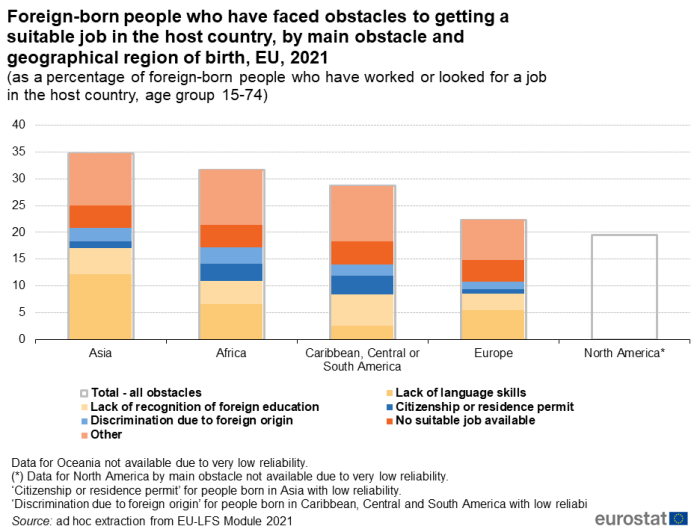Main obstacles for foreign-born people to enter the labour market
Data extracted in January 2023
No planned article update
Highlights
In March 2022, due to the Russian aggression on Ukraine, the EU Council announced the activation of the Temporary Protective Directive. The Directive provides, among other elements, a right to reside and access the labour market in the EU Member States for Ukrainian citizens and other non-EU citizens residing in Ukraine who have received temporary protection. For more information on this topic, please visit the article Temporary protection for persons fleeing Ukraine - monthly statistics.
This article aims to help policymakers by providing data on the obstacles that foreign-born people experience in trying to secure a suitable job in their current host country. The article also presents information on the level of skills that foreign-born people have in the host country's language before migrating, as this might be a factor preventing them from finding a suitable job. The article concludes with information on participation by foreign-born people in a language course after migrating.
Data shown in this article come from the module of the Labour Force Survey (EU-LFS) on the labour market situation of migrants and their immediate descendants held in 2021. The age group focused on in this article is 15-74 years, which is the reference age of the module.
Presented statistics cover the European Union (EU) as a whole and its individual Member States, as well as two European Free Trade Association (EFTA) countries (Norway and Switzerland).
The concept of migration used in this article refers to people residing in an EU Member State and born in another country (that other country can be inside or outside the EU). Therefore, it excludes people coming back to their country of birth after having resided in another country for at least 12 months.
Full article
Presence of obstacles: an overview of foreign-born people
In 2021, almost two-thirds (64.5 %) of all foreign-born people aged 15-74 years residing in the EU declared that they had experienced no obstacles in getting a suitable job in their current host country. 'Suitable job' means a job that matches the person's educational attainment level according to the personal assessment of the survey respondent. By contrast, 23.5 % said that they had faced obstacles, and 12.0 % said that they had never sought work or never worked in their current host country (see Figure 1).
The proportion of foreign-born women who have never faced obstacles in getting a suitable job was considerably lower than the corresponding proportion of men (59.2 % compared with 70.4 %). At the same time, the proportion of foreign-born women who said that they had faced obstacles in getting a suitable job was higher than that of foreign-born men (24.7 % versus 22.2 %). Moreover, there was a higher proportion of women born abroad who have never sought work or never worked in their current host country (these were 16.1 % of foreign-born women, whereas only 7.4 % of foreign-born men had never sought work or never worked in their current host country).
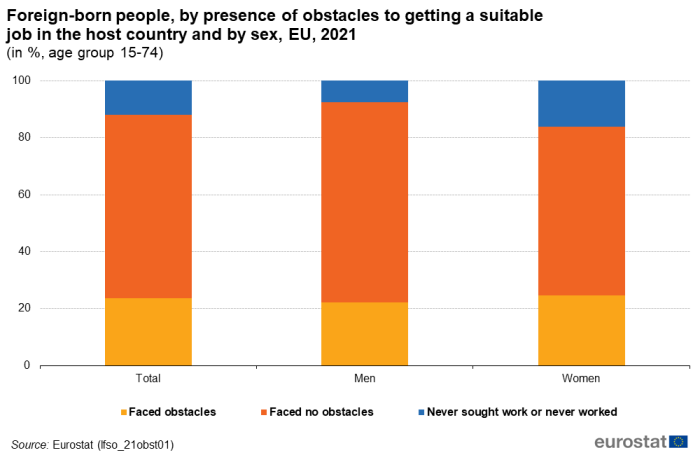
Source: Eurostat (lfso_21obst01)
Figure 2 looks at the reasons that foreign-born people gave for migrating at EU level, and separates these reasons into three categories: people who faced obstacles to getting a suitable job in their host country; people who faced no such obstacles; and people who have never sought work or never worked in their current host country. When looking at the various reasons for migrating broken down in this way, major differences can be seen between men and women.
The percentage of foreign-born men who migrated to find employment (regardless of whether they found a job before migrating) was substantially higher than that of foreign-born women. This is particularly visible among foreign-born people who have worked or who have looked for a job in their host country (i.e. those who could answer the question of whether they had faced obstacles to getting a suitable job in the country they currently reside in). Foreign-born people who migrated to find employment accounted for 35.1 % of men and 24.3 % of women who faced obstacles to getting a suitable job, and 38.6 % of men and 24.7 % of women who faced no such obstacles. It is also worth noting that the percentage of those who migrated for employment having already found a job before migrating was substantially higher among people who faced no obstacles to getting a suitable job in their host country (17.8 % of men and 10.3 % of women), compared with that of those who experienced such obstacles (8.2 % of men and 5.6 % of women).
On the other hand, the percentage of foreign-born people who migrated for family reasons was much higher among women than among men. This difference was most pronounced among those who said they had faced obstacles to getting a suitable job in their current host country (53.3 % of foreign-born women compared with 33.7 % of foreign-born men), and among those who had never sought work or never worked in their current host country, most of whom migrated for family reasons (74.5 % of foreign-born women compared with 56.4 % of foreign-born men).
In addition, 'retirement' as a reason for migrating appears only among foreign-born people who have never sought work or who have never worked in their current host country (6.5 % of men who have never worked or never sought work in their host country migrated for retirement compared with 2.2 % of women).
Figure 2 also includes information on the proportion of foreign-born people who migrated for international protection or asylum. This proportion was higher among men than among women, especially in the group of those who have faced obstacles to getting a suitable job (16.5 % of foreign-born men compared with 8.6 % of foreign-born women). Note that as the results presented in this article refer to 2021, people fleeing the war in Ukraine are not included in these findings.

Source: Eurostat (lfso_21obst03)
Obstacles faced by foreign-born people who have worked or looked for a job
This section of the article will look at the proportion of foreign-born people reporting obstacles to getting a suitable job in their current host country, specifically among all foreign-born people who have worked or who have looked for a job in the host country. In the EU as a whole, this proportion amounted to more than one-quarter, or 26.7 %. Looking at the country level, this proportion also surpassed one-quarter in Italy, Finland, Sweden, France, the Netherlands, Poland and Norway, reaching its highest levels in Italy (41.0 %) and Norway (40.6 %). By contrast, Slovenia, Latvia and Lithuania recorded proportions below 10 % (see Figure 3).
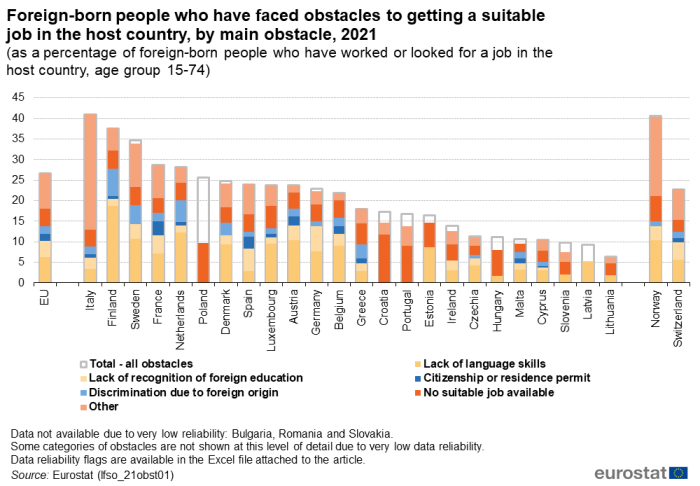
Source: Eurostat (lfso_21obst01)
In the 13 out of 26 countries with available data, the lack of language skills in the host country's language was cited as the most common obstacle to getting a suitable job. The highest percentages of foreign-born people having faced this obstacle were found in Finland (18.8 %), the Netherlands (12.3 %), Sweden (10.8 %), Austria and Norway (both with 10.4 %). The lack of availability of a suitable job was also a commonly cited main obstacle, being predominant in eight countries, with Croatia (11.7 %), Poland (9.6 %) and Portugal (9.0 %) reporting the highest percentages of foreign-born people citing this obstacle.
Looking at the other specific obstacles that foreign-born people have encountered, the highest proportions given for different obstacles are set out in the bullet points below.
- 'Lack of recognition of foreign education': the highest proportions were recorded in Germany (6.2 %), Spain (5.4 %) and France (4.4 %). This category is about the lack of recognition of formal qualifications obtained abroad and covers both the unofficial distrust (among employers) of education or qualifications obtained abroad, and the low level of official validation of foreign education.
- 'Restricted rights to work due to citizenship or residence permit': the highest proportions were recorded in France (3.4 %), Spain (2.9 %) and Austria (2.1 %).
- 'Discrimination due to foreign origin': the highest proportions were recorded in Finland (6.5 %), the Netherlands (5.3 %) and Sweden (4.7 %). This category includes, but is not limited to, nationality, skin colour, accent, and clothing style.
Finally, 'other' obstacle (different to the above-mentioned ones) was the most common main obstacle cited in five countries, with the highest proportions reported in Italy (28.1 %), Norway (19.3 %) and Sweden (10.6 %). The particularly high proportion of 'other' in Italy is because under this category were classified foreign-born people who have worked or looked for a job in Italy, but who have never looked for a job suitable for their level of education. According to the survey's methodology, those cases should be classified under 'other' and not under 'no suitable job available', because of the presumption that the respondents have deliberately looked for a job for which they were underqualified.
Figure 4 shows that at EU level, the percentage of foreign-born women who have faced obstacles to getting a suitable job in the host country was higher than the corresponding percentage of men. This finding holds regardless of the level of education or country of birth (another EU or non-EU country) of the foreign-born person. Furthermore, the proportion of both men and women who have faced obstacles to getting a suitable job increases with the level of education. This might be because people with a higher level of education might have greater expectations about the job they pursue which leads to them encountering more obstacles. Another relevant finding is that the gap between the percentage of men and women also increases with the level of education (this gap is more obvious for people born in another EU country, and less visible for those born outside the EU). Also, men and women born outside the EU are more likely to say that they faced obstacles to finding a suitable job than men and women born in another EU country.
Breaking down the foreign-born population by sex, level of education, and country of birth, the highest proportion at EU level of foreign-born people reporting obstacles to getting a suitable job was 38.3 %, found among women with a high level of education, born outside the EU. This can be contrasted with the 13.5 % of men with a low level of education, born in another EU country who reported obstacles.
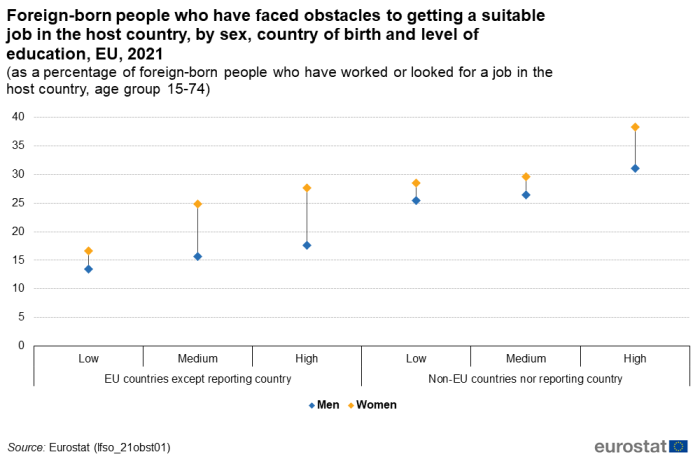
Source: Eurostat (lfso_21obst01)
The proportion of foreign-born people who say they have faced obstacles to getting a suitable job varies according to their current labour status (i.e. whether they are employed, unemployed, or outside the labour force). In all countries with available data for all of the three labour statuses, those who are unemployed reported substantially more often that they faced obstacles to getting a suitable job (see Figure 5). In the EU as a whole, the proportion of foreign-born people saying they faced obstacles to getting a suitable job was 48.8 % among those who were unemployed, compared with 29.4 % among the people outside the labour force and 22.7 % among the employed. At a national level, the proportion of unemployed saying they faced obstacles to getting a suitable job reached around two-thirds in both Finland (66.8 %) and Sweden (66.5 %).
Note that, according to the methodology of the survey, foreign-born people can report having faced obstacles to find a suitable job in the host country, but no specific reference period is mentioned in which the obstacles could have occurred. Nonetheless, given that actively searching for a job is one of the conditions for someone to be classified as unemployed, one might expect that the obstacles to finding a suitable job are more immediately apparent to unemployed people, and that this might explain the much higher percentages of unemployed people who report obstacles to finding a suitable job.
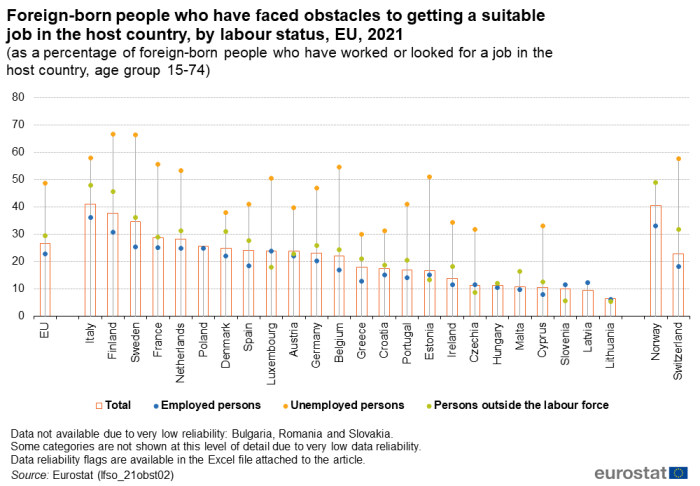
Source: Eurostat (lfso_21obst02)
Figure 6 provides information at EU level on the percentage of foreign-born people reporting obstacles to getting a suitable job by geographical region of birth. The highest proportions were recorded for people born in Asia (34.7 %); followed by those born in Africa (31.7 %); the Caribbean, Central or South America (28.7 %); Europe (22.3 %), and North America (19.5 %).
The spread of the specific main obstacles differs from one region to another. Analysed obstacle by obstacle, the largest regional differences are set out in the three bullet points below.
- 'Lack of language skills' was reported as an obstacles by 12.1 % of foreign-born people from Asia, 6.7 % of those from Africa, 5.4 % of those from Europe, and 2.6 % of those from the Caribbean, Central or South America.
- 'Restricted rights to work due to citizenship or residence permit' was reported by 3.5 % of foreign-born people from the Caribbean, Central or South America; 3.2 % of those from Africa; 1.2 % of those from Asia, and 0.8 % of those from Europe.
- 'Discrimination due to foreign origin' was reported by 3.1 % of foreign-born people from Africa; 2.5 % of those from Asia; 2.0 % of those from the Caribbean, Central or South America; and 1.3 % of those born in Europe.
Language proficiency before migrating and participation in language courses after migrating
More than half of people born abroad and residing in Croatia, Hungary, Portugal, Ireland and Spain were proficient users of the respective country's language before migrating or had spoken it as a mother tongue (see Figure 7). Furthermore, Hungary (74.8 %), Portugal (70.6 %) and Croatia (67.8 %) had the highest proportions of people born abroad who, before migrating, had spoken Hungarian, Portuguese and Croatian respectively as a mother tongue. By contrast, more than three-quarters of people born abroad and residing in Malta, Slovenia, Denmark, Sweden, and Norway had hardly any – or no – language skills in the languages of those countries before migration. Note that in the Maltese survey, the question about language proficiency before migration was asked about the Maltese language and not about English.
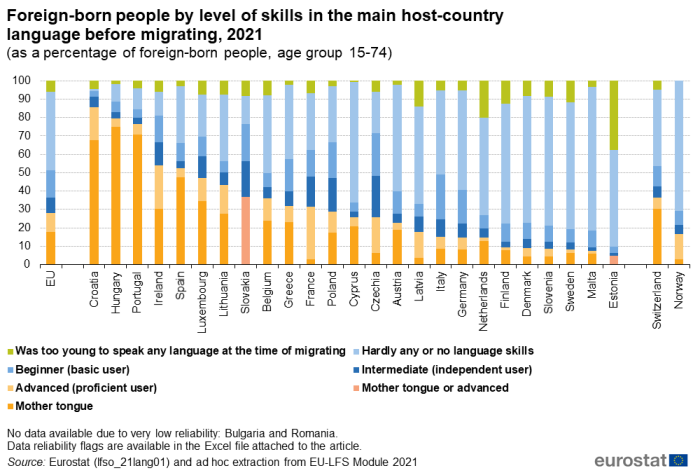
Source: Eurostat (lfso_21lang01) and ad hoc extraction from EU-LFS Module 2021
Figure 8 shows that the proportion of foreign-born people who could speak the host country's language proficiently or as a mother tongue before migrating differs significantly by country of birth (i.e. it differs depending on whether the foreign-born person was born in another EU country or in a non-EU country). Moreover, this difference had an 'opposite' direction in different countries. In Croatia, Portugal, Ireland, Spain, France, the Netherlands and Malta, the percentage of people born in a non-EU country who could speak the host country's language proficiently or as a mother tongue was higher than that of people born in another EU country. The situation in the remaining countries with available data for the two categories of country of birth was the reverse, i.e. there were higher percentages of people who could speak the host country's language proficiently or as a mother tongue for those born in another EU country than for those born in a non-EU country.
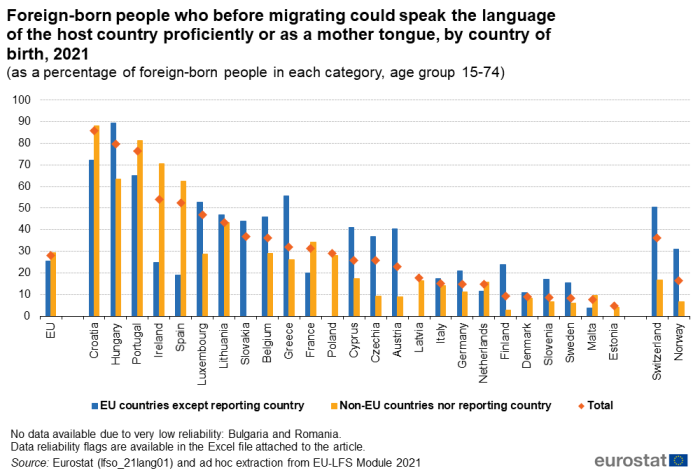
Source: Eurostat (lfso_21lang01) and ad hoc extraction from EU-LFS Module 2021Figure 8
What about participation in language courses?
More than 50 % of foreign-born people in Denmark, Finland, Luxembourg, Sweden and Germany, as well as in Norway, said they had participated in a language course (general or work-specific) in the corresponding languages of those countries after migration (see Figure 9). Work-specific language courses were not very common. However, relatively large percentages of foreign-born people had attended work-specific language courses in Luxembourg (21.4 %), the Netherlands (16.2 %), and Norway (35.4 %).
By contrast, at least 90 % of foreign-born people in Croatia, Portugal, Lithuania and Hungary have not participated in a course in, respectively Croatian, Portuguese, Lithuanian, and Hungarian, after migration, primarily because their language skills have been already sufficient.
More than 10 % of foreign-born people in Italy, Greece, Slovenia, Cyprus and Austria (and as high as 27.5 % in Italy) declared that language courses in the host country's language had not been available or affordable in those five countries.
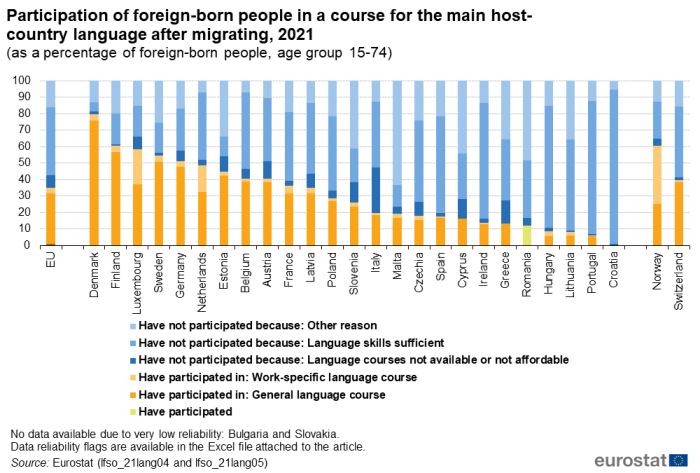
Source: Eurostat (lfso_21lang04) and (lfso_21lang05)
Source data for tables and graphs
Data sources
The European Union Labour Force Survey (EU-LFS) is the largest European household sample survey providing quarterly and annual results on labour market characteristics of people.
EU-LFS covers the resident population, defined as all people usually residing in private households.
'Usual residence' means the place where a person normally spends the daily period of rest, regardless of temporary absences for purposes of recreation, holidays, visits to friends and relatives, business, medical treatment or religious pilgrimage. The following persons alone are considered to be usual residents of a specific geographical area:
- (a) those who have lived in their place of usual residence for a continuous period of at least 12 months before the reference time; or
- (b) those who arrived in their place of usual residence during the 12 months before the reference time with the intention of staying there for at least one year.
Where the circumstances described in point (a) or (b) cannot be established, 'usual residence' can be taken to mean the place of legal or registered residence.
The concept of migration used in this article refers to people residing in an EU Member State and born in another country (inside or outside the EU). It consequently excludes people coming back to their country of birth after having resided in another country for at least 12 months.
The level of education refers to the educational attainment level, i.e. the highest level of education successfully completed. Low level of education refers to ISCED levels 0-2 (less than primary, primary and lower secondary education), medium level refers to ISCD levels 3 and 4 (upper secondary and post-secondary non-tertiary education) and high level of education refers to ISCED levels 5-8 (tertiary education).
Since 1999, an inherent part of EU-LFS has been the modules. These were called 'ad hoc modules' until 2020. From 2021 onwards, they are called either 'regular modules' when the variables have an 8-yearly periodicity or 'modules on an ad hoc subject' for variables not included in the regular datasets. In 2021, EU-LFS included a module on the labour market situation of migrants and their immediate descendants. From that year onwards, this module will be conducted regularly every eight years under Regulation (EU) 2019/1700.
For further information on the EU-LFS modules, please refer to the article on this subject.
Coverage: The 2021 EU-LFS module on the labour market situation of migrants and their immediate descendants covers all European Union Member States and the EFTA Member States Norway and Switzerland. For Cyprus, the survey covers only the areas of Cyprus controlled by the Government of the Republic of Cyprus.
European aggregates: EU and EU-27 refer to the sum of the 27 EU Member States. If data are unavailable for a country, the calculation of the corresponding aggregates takes into account the data for the same country for the most recent period available. Such cases are indicated.
Calculation of percentages
All of the figures in this article present percentages of a total. The calculation of all percentages used in this article is based on a total excluding the number of people classified in the non-response category. As such, all exhaustive breakdowns presented in the figures should sum to 100 % (allowing for rounding errors). If a given category is not available (e.g. due to low reliability), and is the only one missing in a sum up to 100 %, then the percentage for this category is subtracted from 100 %.
Context
The continued development and integration of EU migration policy remains a priority in order to meet the challenges and harness the opportunities that migration represents globally. The integration of nationals of non-member countries legally living in the EU Member States has gained increasing importance in the EU agenda in recent years.
There is a strong link between integration and migration policies since successful integration is necessary for maximising the economic and social benefits of immigration for individuals as well as societies. EU legislation provides a common legal framework regarding the conditions of entry and stay and a common set of rights for certain categories of migrants. More information on the policies and legislation in force in this area can be found in an introductory article on migrant integration statistics.
The Temporary Protection Directive, which was adopted following the conflicts in former Yugoslavia, was triggered for the first time by the Council in response to the unprecedented Russian invasion of Ukraine on 24 February 2022 to offer quick and effective assistance to people fleeing the war in Ukraine.
Indeed, Russia's military invasion of Ukraine has created a situation of mass arrivals of displaced people from Ukraine unable to return to their homes. Due to the scale of estimated arrivals, the European Commission identified a clear risk that the asylum systems of EU countries would be unable to process applications within the deadlines set. This would negatively affect the efficiency of national asylum processes and adversely affect the rights of people applying for international protection. Following the call of the home affairs ministers, on 2 March 2022, the Commission rapidly proposed to activate the Temporary Protection Directive and, on 4 March 2022, the Council unanimously adopted the Decision giving those fleeing war in Ukraine the right to temporary protection.
This right to temporary protection is associated with facilities offered in relation to access to employment, participation in language courses in the host country language as well as recognition of qualifications obtained abroad. Obstacles to enter the EU labour market should be minimised as much as possible to facilitate the successful integration of migrants into society in the host country.
In this context, the EU-LFS 8-yearly regular module on the labour market situation of migrants and their immediate descendants implemented in 2021 can bring crucial information on the labour market integration and level of skills and qualification of the migrants as well as on obstacles that migrants can face on the EU labour market. This could help EU policy-makers in adjusting their migration and integration policies.
Direct access to
See also
- Self-perceived discrimination at work - statistics
- Main characteristics of foreign-born people on the labour market
- Employment - annual statistics
- Unemployment statistics and beyond
- Labour market slack - employment supply and demand mismatch
- All articles on employment
- Migration and migrant population statistics
Dedicated section
Methodology
Publications
- Labour force survey in the EU, EFTA and candidate countries — Main characteristics of national surveys, 2020, 2022 edition
- Quality report of the European Union Labour Force Survey 2020, 2022 edition
- EU labour force survey — online publication
ESMS metadata files and EU-LFS methodology
- Employment and unemployment (Labour Force Survey) (ESMS metadata file — employ_esms)
- LFS ad-hoc modules (ESMS metadata file — lfso_esms)
- EU labour force survey — online publication
- Migrant integration statistics — online publication
- Foreign-born people and their descendants — online publication
